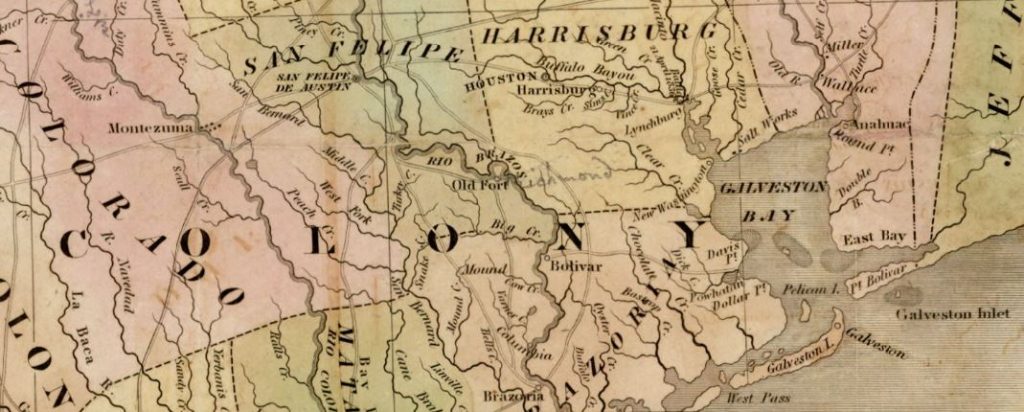
The table below shows the chronological order of the family arrivals in Texas starting when Texas was a northern province of Mexico, through the Republic of Texas, and continuing into the early 20th century. Included here are biographies of the Maiden, Scott, Lawrence, and Townsend families who arrived in the early 19th century and played roles in the birth of Texas.
Townsend ancestors in order of their arrival in Texas
| Arrival | Ancestor | Descendant |
| 1825 | Peggy Hershberger Maiden with her new husband Joseph San Pierre and her children Nancy and Isaac Maiden – Part of Austin’s “Old 300” settlers – Brazoria County | Vann |
| 1830 | Jonathan Hampton Scott – DeWitt Colony – Lavaca County west of Hallettsville | Vann |
| 1835 | George Washington Lawrence – Sabine district – soldier at San Jacinto | Earley |
| 1835 | Mills and Elizabeth and Sarah Whitley – Sabine district | Earley |
| 1838 | Asa and Rebecca Harper Townsend – Colorado County | Townsend |
| 1845 | Jacques and Catherine Claudierez Tacquard with their son Jacques – Indianola | Vann |
| 1845 | Jean and Mary Ann Chembert Bouthery – Indianola | Vann |
| 1848 | Wilson Wade Vann – Brownsville | Vann |
| 1848 | Alfred and Delilah Morgan Bishop and their daughter Margaret – Fayette County | Vann |
| by 1850 | Johanne Caspar and Louisa Eilers Fink – La Grange | Townsend |
| 1856 | Malachi Weston – Kerr County | Vann |
| 1857 | Anne Hervey – Dewitt County | Townsend |
| by 1860 | George Henry and Louisa Hughes Price and son James – Kosse | Earley |
| by 1865 | Susanna Smith – Walker County | Earley |
| by 1870 | Edmund and Rebecca Moore Price – Kosse | Earley |
| 1875 | John and Elizabeth Dobson Ireland – Zorn | Callcott |
| by 1880 | Norman “Lit” Earley and his mother Elizabeth – Walker County | Earley |
| 1885 | George H. and Polly Ireland Callcott with son Herbert Hardy – San Marcos | Callcott |
| 1890 | Mattie Dees with her mother Louisa Josey – Kosse | Earley |
| 1892 | Nellie McCracken with her mother and siblings – Dallas area | Callcott |
| 1911 | George L. and Alice Palmer Fisher with daughter Velma – Houston | Townsend |
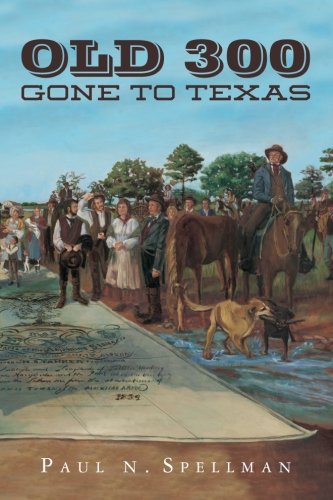
Margaret and Nancy Maiden
Margaret “Peggy” Harshbarger Maiden San Pierre arrived in 1825 with her daughter Nancy (ancestor), son Isaac, and husband Joseph San Pierre as part of Austin’s “old 300” original settlers. Margaret and her daughter Nancy were the first members of the Townsend family on either side to arrive in what was to become Texas. Her son, Isaac later fought at San Jacinto and her daughter, Nancy married Jonathan Hampton Scott, an early Texas Ranger who fought in several notable battles against both Indians and Mexicans, and later became the first Chief Justice of Kerr County.
Peggy was born in 1780 and married Isaac or James Maiden before 1804. Their first son, Isaac, was born in 1805. Their daughter Sarah was born in 1812 and Nancy in 1814 in Millers Run near Pittsburgh, PA. This is very near the area where Johnathan Hampton Scott was born and raised before he emigrated to Texas, so it’s possible that Jonathan made the connection with the Maidens in Pennsylvania.
Nancy’s father died in 1819 in Indiana. Peggy married Joseph San Pierre later that same year. In 1825 the San Pierre family became one of Stephen Austin’s “old 300” families to colonize the Brazos River valley in the Mexican state of Texas. They emigrated to Texas when Nancy was 11 and settled in the Brazos River valley near the present town of Pittsville on one labor of land (a Spanish measurement of area equal to 177 acres).
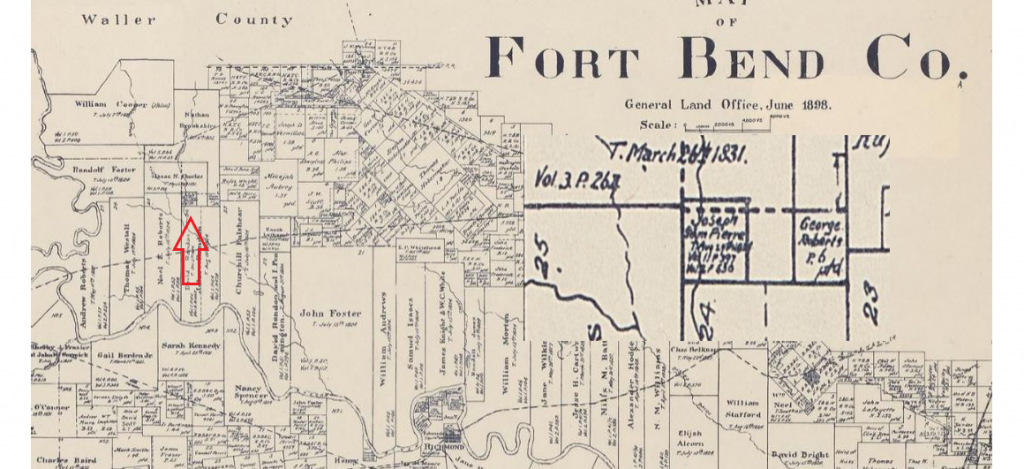
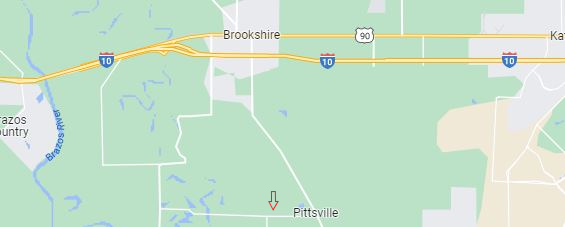
You can drive to the site of the first parcel of land owned by the family in Texas. Take the Brookshire exit from I-10 and drive about four miles south on Waller Avenue to the town of Pittsville. In the center of town take Hunt Road due west for about one mile until it crosses Brookshire Creek. The original San Pierre labor of land extends both north and south from the creek crossing.
The following paragraphs are an excerpt from the diary of Patrick Martin Sampier. He was Peggy’s son born in Texas to Joseph San Pierre. Patrick is describing events between 1826 and 1838:
“P.M. Sampier was born in Fort Bend County, Texas near the present town of Pittsville on the Brazos Bottom, May 10th, 1826. His parents Joseph San Pierre and Margaret San Pierre (they changed their name to Sampier) having settled that place two years before. In 1828 his parents moved to Brazoria Co. and settled near the town of West Columbia where his father died on Oct. 1832, from the effects of a rusty nail in his foot.
His mother remained on the place until after the invasion of Texas by Santa Anna in 1836 when she in common with all the families moved or rather ran off ahead of the retreating Texans and advancing Mexicans, until we were stopped in front by floods in the Trinity and Neches rivers and while water bound in front the ever to be remembered Battle of San Jacinto was fought and the glorious news of Texas liberty was sent on after the people that more who might return home again.
My mother had a son in that little army, and she wanted to know if he was dead or alive. So, we came back by the battlefield and went to the grave of those killed and while the name of Isaac Maiden, her son, was not there, sad it was to read the name of Lem Blakely, who with his brother Edward, had went from Mother’s house with her son to the army who was with him in Vallasco 1832 and at the storming of the Alamo in 1835 under Burleson and Milam.
Mother did not see her son until she got home to Columbia and there, we got to see the Mexican’s Generals Lopez De Santa Anna and his Secretary Al Monte and Gen. Coss they kept in a house not far from my mother’s residence.
My mother then moved into Columbia where she lived until October 1837 when she also died, leaving three sons of whom the writer was the youngest (at 11 years old). The other two, James M. and Joseph 15 and 18 years old. P.M. Sampier was taken to Jackson Co. in Texas to live with a man by the name of Johnathan Scott (ancestor), who had married Nancy Maiden (ancestor), a half-sister, and was there until July when Sam Chance who had married Sarah Maiden, another half-sister and lived in Milam Co. and was appointed guardian for me (at age 12). So, I went to Milam Co. in Aug. 1838. “
Joseph San Pierre was a man of some wealth. Between 1826 and his death in 1832 he bought several Leagues of land in Brazoria, Jackson County, and north of Bastrop. The family had relocated south to Columbia in 1828 where San Pierre died in 1832. Peggy’s daughter Nancy Maiden married Jonathan Scott in 1833 in Brazoria. The Scotts may have lived on Jonathan’s Jackson County property on the Navidad River where their daughter Caroline (ancestor) was born in 1837. After Texas independence Peggy lived the final year of her life in Columbia.
The following is taken from the Battle of San Jacinto website:
“MAIDEN, ISAAC — In applying for land in Austin’s Colonies, Mr. Maiden stated that he was born in 1805 and had arrived in Texas from Indiana in 1824 or 1825; On June 16, 1831, title to one-fourth of a league of a land was issued in the name of Isaac Maden. The land was surveyed in the present County of Lavaca County east of the Navidad, in Austin’s Second Colony. Isaac Maiden was issued a Headright Certificate for one-twelfth of a league of land by the Milam County Board of Land Commissioners in 1838.
From Wikipedia: The word “league” was used in the archaic system of old Spanish land grants affecting Texas and parts of adjoining states and this use of league is used throughout the Texas Constitution. A “league” is a unit of area, used to express the area of land, that is equal to 25 million square varas. A (square) league is equivalent to about 4,428.4 acres.
In Vol. 1, page 113 of the Lamar Papers, it is shown that Mr. Maiden participated in the battle of Velasco in June 1832. At San Jacinto he was a member of Captain Thomas H. McIntire’s Company, but he did not apply for the 640 acres of donation land due him for having participated in the battle. Neither did he receive the bounty land he was entitled to receive.”
Isaac owned land in Jackson County south of Jonathan Scott and also a town lot in Gonzales also near the Scotts. He died in October 1841.
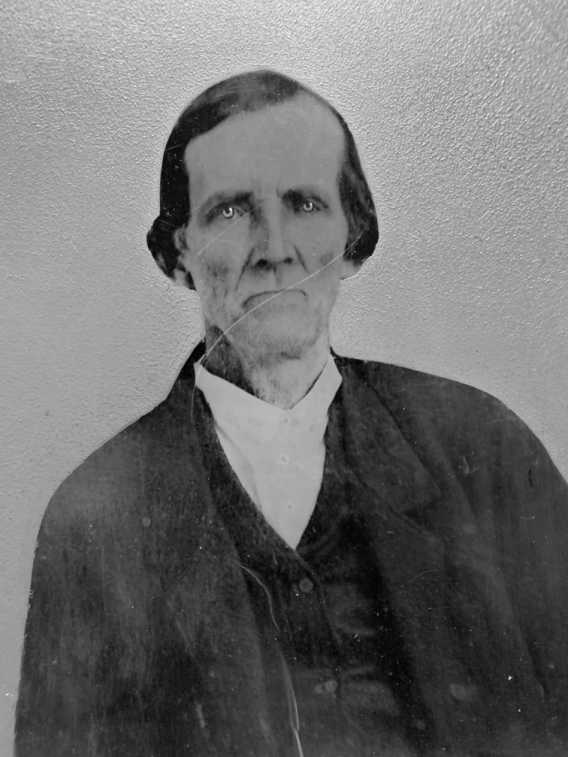
Jonathan Hampton Scott
Jonathan Hampton Scott was born 27 Jan 1809 in Millers Run, Pennsylvania (the same place his future wife was born in 1814). He was son of John Scott and Esther Phillips and grandson of Jonathan Phillips (1746-1830) and Samuel Scott, Sr. (1751-1819), both veterans of the Revolutionary War. Jonathan and his family clan were descended from Irish and Scots-Irish immigrants to Pennsylvania. They lived in Washington County, Pennsylvania near The National Road that ran from the East Coast to the Ohio valley.
Follow this link to learn about his immigrant Scots-Irish grandparents.
According to land grant records, Jonathan Scott arrived in the DeWitt colony 20 Jul 1830 as a single man and received a quarter sitio (about 1,100 acres. A sitio was about one league – just over 4,400 acres) of land on Rocky Creek west of Hallettsville in current Lavaca County. At the time the entire population of the colony was 574 people.
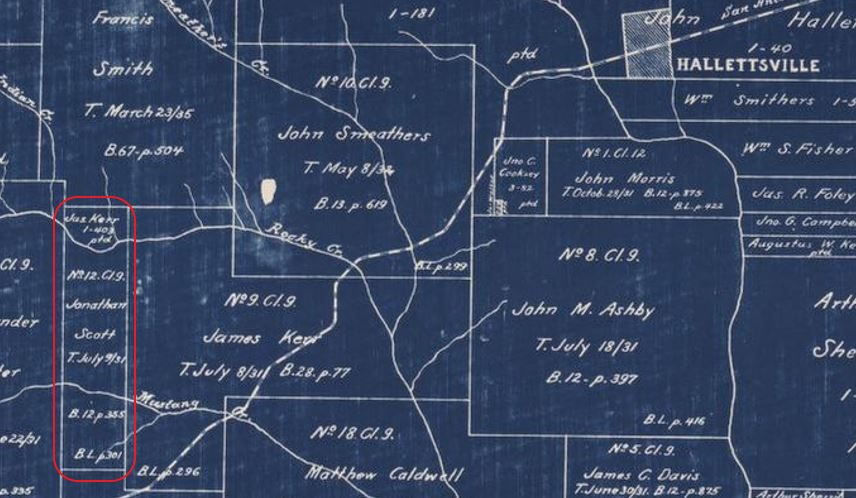
His neighbor to the east was James Kerr and prominent figure in early Texas history and the namesake of Kerr County, Texas. East of Halletsville was land owned by Jim Bowie.
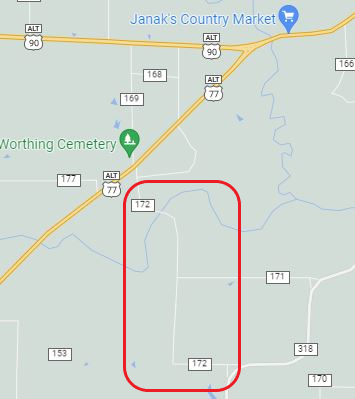
To get there today take Alt 90 west from Halletsville and turn left on Alt 77. Travel a half mile and turn left again on County Road 172. After you cross Rocky Creek in about a half mile you will be on the Scott land grant.
Jonathan bought more land in DeWitt’s Colony (now Lavaca and Jackson Counties) on July 9, 1831. The Texas Land Office map of original land owners of Jackson County show Jonathan’s property with adjacent land owned by Isaac Maiden:
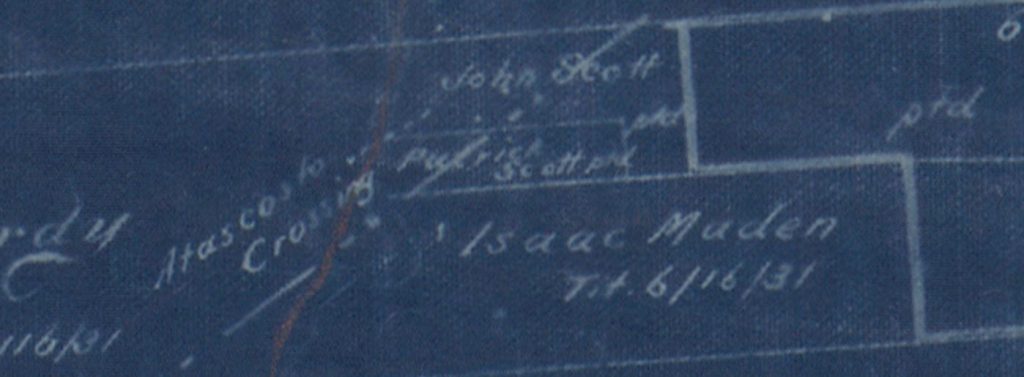
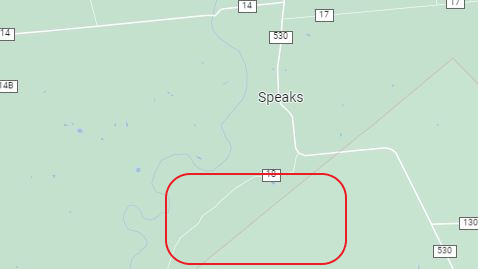
This property is located on the east bank of the Navidad River near the border between Lavaca and Jackson Counties. Scott’s land is where the Old Atascacito Road crossed the Navidad. To get there today drive south on County Road 550 for less than a mile from Speaks, Texas and turn right on County Road 18. The land is on the west side of the road in about one mile.
Jonathan married Nancy Maiden on 12 Nov 1833 in Brazoria County where she was living with her widowed mother Peggy San Pierre. He and Nancy purchased a lot from J. C. Davis on December 29, 1834. He bought 1/4 league (1,104 acres) of land in what is now Lavaca County in the spring of 1835 where their daughter Margaret was born that year. In 1837 their daughter, Caroline (ancestor) was born in Jackson County, Texas.
Jonathan arrived in DeWitt’s colony as a 20-year-old single man with a family heritage of military service. Able bodied men formed militias to defend against Indian raids and Jonathan started on his career as an Indian fighter in a group that was the precursor to The Texas Rangers. He also served as a Republic of Texas militia soldier. He later served in the Indian Wars conducted by Col. John H. Moore of Fayette County. He was in Capt. Clark L. Owens’ company with an expedition in the spring of 1835 at Sandies in Gonzales County that ambushed a large band of Indians that massacred 13 French and Mexican traders.
The following is an account of that battle:
Massacre on the San Marcos at Castleman’s 1835 From John Henry Brown’s History of Texas:
“In the autumn of 1833 John Castleman, a bold and sagacious backwoodsman, from the borders of Missouri, with his wife and four children, and his wife’s mother, settled fifteen miles west of Gonzales, on Sandy Creek, on the San Antonio Road. He was a bold hunter, much in the forest, and had four ferocious dogs, which served as sentinels at night, and on one occasion had, a terrible fight with a number of Indians who were in the yard endeavoring to steal horses tied around the house. The dogs evidently inflicted severe, punishment on the savages, who left abundant blood marks on the ground, and were glad to escape without the horses. In doing so in sheer self-defense, the Indians killed the dogs. Castleman, in his wanderings, was ever watchful for indications of Indians, and thus served as a vidette to the people of Gonzales and persons traveling that exposed road. Many were the persons who slumbered under his roof rather than camp out at that noted watering place.
In the spring of 1835, a party of thirteen French and Mexican traders, with pack mules and dry goods from Natchitoches, Louisiana, en route to Mexico, stopped under some trees a hundred yards in front of the cabin. It was in the forenoon, and before they had unpacked Castleman told them that he had that morning discovered Indian signs nearby and urged them to camp in his yard and use his house as a fort if necessary. They laughed at him. He shrugged his shoulders and assured them they were in danger, but still they laughed. He walked back to his cabin, but before he got there about a hundred mounted savages dashed among them, yelling and cutting out every animal belonging to the party. These were guarded by a few Indians in full view of the camp, while the main body continued the fight. The traders improvised breastworks of their saddles, packs and bales of goods and fought with desperation. The engagement lasted four hours, the Indians charging in a circle, firing, and falling back. Finally, as none of their number fell, the besieged being armed only with Mexican escopetas (smooth-bore cavalry guns) they maneuvered till all the traders fired at the same time, then rushed upon and killed all who had not previously fallen. Castleman could, many times, have killed an Indian with his trusty rifle from his cabin window, but was restrained by his wife, who regarded the destruction of the strangers as certain, and contended that if her husband took part, vengeance would be wreaked upon the family—a hundred savages against one man. He desisted, but, as his wife said, “frothed at the mouth” to be thus restrained from action on such an occasion. Had he possessed a modern Winchester, he could have repelled the whole array and saved both the traders and their goods.
The exultant barbarians, after scalping their victims, packed all their booty on the captured mules and moved off up the country. When night came Castleman hastened to Gonzales with the tidings and was home again before dawn. In a few hours a band of volunteers, under Dr. James H. C. Miller, were on the trail and followed it across the Guadalupe and up the San Marcos, and finally into a cedar brake in a valley surrounded by high hills, presumably on the Rio Blanco. This was on the second or third day after the massacre. Finding they were very near the enemy, Miller halted, placing his men in ambush on the edge of a small opening or glade. He sent forward Matthew Caldwell, Daniel McCoy and Ezekial Williams to reconnoiter. Following the newly made path of the Indians through the brake, in about three hundred yards, they suddenly came upon them dismounted and eating; they speedily retired, but were discovered and, being only three in number, the whole crowd of Indians furiously pursued them with such yells as, resounding from bluff to bluff, caused some of the men in ambush to flee from the apparent wrath to come; but of the whole number of twenty-nine or thirty, sixteen maintained their position and their senses. Daniel McCoy, the hindmost of the three scouts in single file, wore a long-tail coat. This was seized and tightly held by an Indian, but Old Dan, as he was called, threw his arms backward and slipped from the garment without stopping, exclaiming, Take it, d—n you. Caldwell sprang, first into the glade, wheeled, fired and killed the first Indian to enter. Others, unable to see through the brush till exposed to view, rushed into the trap till nine warriors lay in a heap. Realizing this fact, after such unexpected fatality, the pursuers raised that dismal howl which means death and defeat and fell back to their camp. The panic among some of our men prevented pursuit. It is a fact that among those seized with the “buck-ague,” were men then wholly inexperienced, who subsequent1y became distinguished for coolness and gallantry.
Among others, besides those already named, who were in this engagement, were: Wm. S. Fisher, commander at Mier seven years later; Bartlett D. McClure, died in 1841; David Hanna, Landon Webster and Jonathan Scott. It is painful to add that this Dr. Miller, later in the same year, became a tory, and left the country, never to return.”
http://www.tamu.edu/faculty/ccbn/dewitt/indiantales.htm
It will be interesting to learn what part Jonathan played in the Texian army. He received bounty land grants for his service in the Army of the Republic of Texas. He was a 3rd Corporal of Capt. Clark L. Owens Co. A of the Permanent Volunteers from June to December 1836.
The following entries for Jonathan Scott’s service can be found in Index to Military Rolls of the Republic of Texas 1835-1845:
Company Commander Thomas H. Breece, Texas Volunteers, in the Army before Bexar 1835
Company Commander Clark L. Owen, Company A, 1st Regt. Permanent Volunteers, Joseph H.D. Rogers Command, Dept. Matagorda, Camp Independence Oct 31, 1836 to Dec 31, 1836. (This is where the main Texan army was encamped after the Battle of San Jacinto. It was about 20 miles south of Jonathan’s land on the Navidad River.)
Company Commander H. H. Brower, Company [A], [Gen. James Davis Comm.] May 15, 1842, Lipantitlan Department (Canales Campaign). Jonathan was a corporal in the Texas Army at the Battle of Salado Creek.
Company Commander John S. McNeel, 1 Regt. South Western Army Mustered by Jas. R. Cook, Enlistment from Oct 2, 1842 to Nov 20, 1842 Dep: [San Antonio, Camp Cooke, Somervell Campaign]
After the war Jonathan was a Steward in the Jockey Club in Seguin, TX from June 23, 1836 to Dec 1843. Between 1837 and 1842 the family was living in Gonzales. Probably on their 6 lots in the west outer Gonzales town tract between the San Marcos River and Water St (see map below). This map tells us the location of Jonathan Scott’s land holdings in the town of Gonzales. The modern-day Highway 90 is the southern border of Scott’s property. Note that just south of Scott’s property was the land of Almeron Dickinson one of the defenders of the Alamo and his wife Susanna who was one of the few survivors of the battle. Jonathan’s brother – in – law, and San Jacinto soldier, Isaac Maiden’s property is a few blocks further south.
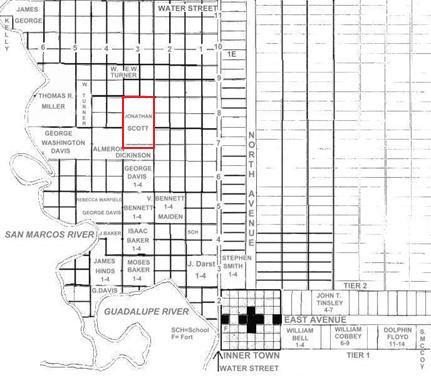
He served in Capt. Adam Zumwalt’s Company of Lavaca River minutemen in the Battle of Salado in Sept 1842 in which the Army of the Republic drove Gen. Woll’s Mexican forces who had captured San Antonio back to the Rio Grande River. He was in the Texan force that pursued Gen. Woll’s troops to the border but returned to San Antonio to be discharged on 7 Jan 1842.
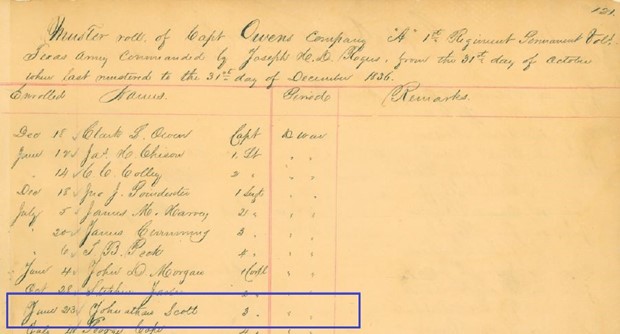
Nancy died in Gonzales in 1842 and Jonathan married Diana J. Brown on December 17, 1843. Jonathan and Diana had five children together. While living in Gonzales County, he received $67.50 on Sept.1, 1852 for his service in the Republic of Texas Army.
When Kerr County was formed in 1856 Jonathan was appointed its first Chief Justice and served until 1862. Jonathan was a stock raiser and farmer, in addition to his county duties. He registered his brand in Kerr County. While they lived in Kerrville his daughter Caroline, who by then was the widow of George New, married Malachi Weston (ancestor).
Jonathan and Diana returned to Gonzales after his term of office ended in 1862. Jonathan passed away in Gonzales in 1874. Diana applied for the Texas Army Widow’s Pension on March 8, 1874. According to the Gonzales County Historical Society Jonathan was “buried near Nixon, Texas on the old Judge Green place near a creek. This may have become the Rancho Cemetery in Nixon. There is no visible grave marker there.
https://www.findagrave.com/cemetery/7601/rancho-cemetery
George Washington Lawrence
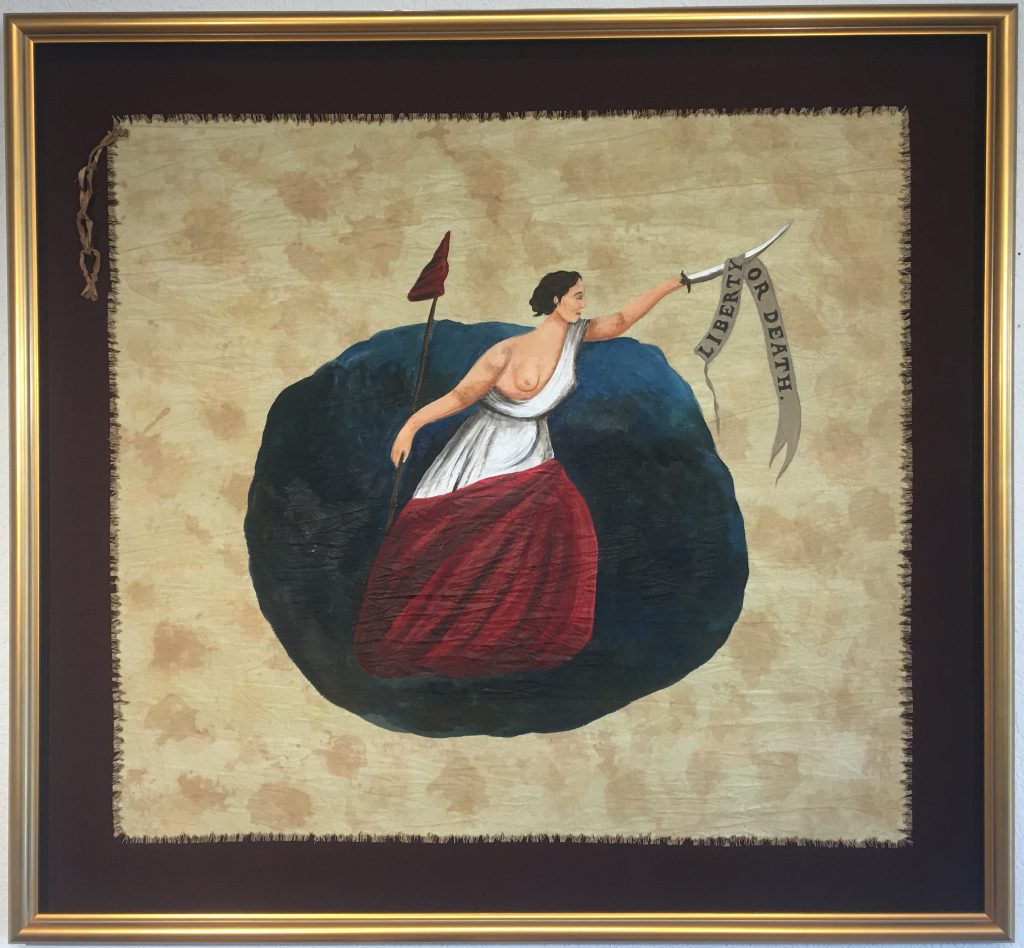
George Washington Lawrence (Earley Ancestor) was born on April 6, 1811, in Lee County, Virginia. In the headright certificate issued to George W. Lawrence June 6, 1838, by the Montgomery County Board of Land Commissioners it is stated that he came to Texas in January 1835. In the army roll in the General Land Office he is shown as having enlisted in the army on March 12, 1836. He was a member of Captain William Ware’s Company at San Jacinto and on January 2, 1839, he was issued a donation certificate No. 729 for 640 acres of land for having participated in the battle. He did not apply for the land due him for his services in the army immediately prior to and after the battle. He was issued a bounty certificate No. 28 for 320 acres of land May 5, 1846, for having served in the army from June l to September 19, 1836. This he sold to Peter Shamburger for $25.00. He could not write, affixing his “Mark” to the deed of transfer.
Mr. Lawrence died in Walker County March 12, 1860. (Book D, page 418, Probate Minutes of Walker County.) His son, Charles Lawrence, was appointed administrator of his estate. He married Sarah Whitley and had the following children: Charles Lawrence (ancestor); Mills Whitley Lawrence; John Lawrence; William B. Lawrence; George Washington Lawrence; Randolph Little Lawrence; Sarah Elizabeth Lawrence.
Excerpted from “Huntsville and Walker County, Texas: a bicentennial history” pages 503-504 at the Montgomery County Library:
“This all began when George Washington Lawrence came to Texas from Illinois in January of 1835. He came with his wife Sarah Whitley and her father, Mills Whitley and mother Elizabeth Little and her brothers and uncles. They are in the first census of Texas, and they were in the Sabine District in 1835, then moved on into Texas. He is listed on the Army Roll in the General Land Office, and he enlisted in the Army March 12, 1836. He was a member of Captain Ware’s Company at the Battle of San Jacinto. On January 2, 1839, he was issued Donation Certificate No. 725 for 640 acres of land for participating in the battle. He had a headright certificate issued June 6, 1838, by the Montgomery County Board of Land Commissioners.
George Washington Lawrence was born April 6, 1811, in Lee County Virginia and died March 12, 1860, in Walker County, Texas. He was married to Sarah (Sally) Whitley on September 4, 1834, in Coles County, Illinois. She was born January 6, 1815, in Bond County, Illinois and died November 25, 1870, in Caldwell County, Texas. She was the daughter of Mills Whitley and Elizabeth Little.
George W. Lawrence died without leaving a will. His oldest Son, Charles Lawrence, was appointed administrator of the estate. He left 2952 acres of land in Bexar County, 640 acres of land in Gillespie County, and 100 acres of land in Walker County.”
The Lawrence family farm was in Walker County east of New Waverly. GW Lawrence’s grave location is unknown.
George’s wife Sarah Whitley was the daughter of Mills and Elizabeth Little Whitley. The family came to the Mexican state of Texas in 1835 and settled on a league of land in what is now walker county.
The Whitley Family
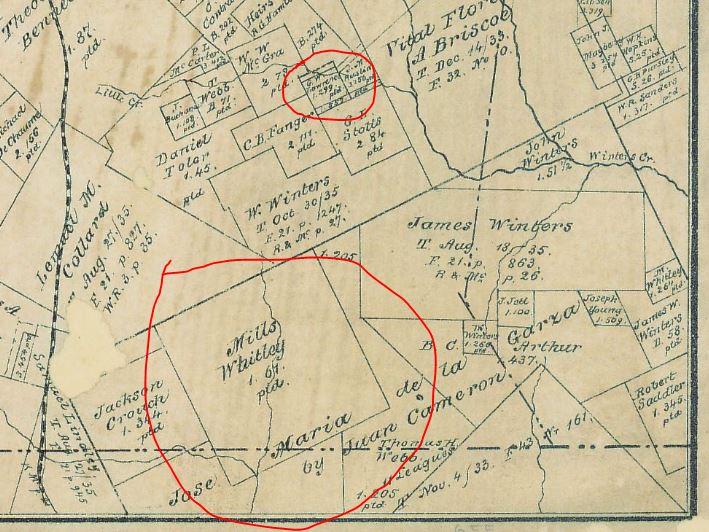
The Story of the Whitley and Little families and associated kinship groups migration from Europe to the American Colonies to the newly opened Midwest and on to Texas.
The Following are excerpts from: East Texas Historical Journal Volume 53 | Issue 1 Article 5 “A Road Less Traveled: or Some Antebellum Arrivals to Texas Out of Illinois” 3-10-2015
“The story of this kinship network dramatically illustrates the reciprocal interaction of three powerful nineteenth century forces: kinship, migration, and settlement patterns, all influences that combined to populate the steadily westward moving nineteenth-century American agricultural frontier. The group’s movements into Illinois, within Illinois, and subsequently to and throughout Texas illustrate two of the most potent push-pull factors that became the deus ex machina that rapidly filled fertile, open frontier lands inviting aggressive settlement.
Pulling eager migrants was inexpensive farmland—initially Illinois tracts selling at $2.00 an acre and, later still, the even less expensive league and labor—4,605 acres— available to married men who moved to Texas. Both opportunities had tremendous appeal. Both were early versions of “The American Dream,” the prospect of landownership that had drawn Europeans across the Atlantic since the very establishment of England’s New World colonies. A different force pushed at least some nineteenth century Americans from the established settled regions in the east to the periphery, to the edge of the unused. This class of migrant often exhibited an inborn claustrophobia. The urge, the itch to move to free and open spaces became irresistible as each new thinly populated agricultural frontier began to resemble those more heavily settled areas from which such migrants had most recently come
It is difficult today to fathom the importance of extended family in the lives of most antebellum southerners. From the First Families of Virginia to common Virginian farming families, thick kinship ties, especially in frontier settings, often included double cousins—the product of siblings in one family marrying brothers or sisters from another—and, in a tradition surprisingly commonplace among those with Virginian roots, even occasional first-cousin marriages. Such powerful links magnified the importance of family in extraordinary ways, especially during the extended family’s initial decade in a new location. Some members of the kinship pentapolis first met in Illinois, but others forged critical connections well before the group converged on southern Illinois’ frontier. The trail each family left along respective routes remains discernible.
Over the decades, some of these families retained oral traditions, particularly about routes taken from southern Tidewater states to Illinois and subsequently to Texas. On the one hand, the credibility of such “histories” can be suspect. On the other, these traditions assume authenticity when considered in light of consistent affirming nativity information preserved in the four federal population censuses from 1850 through 1880. Where a credible trail exists prior to the family’s arrival in America, it unfailingly leads to the British Isles.
Such was the case for the Whitleys whose European origins extend to Frodsham in England’s County Cheshire. The family reached Virginia in the early-seventeenth century, ultimately taking up long-term residence in the “Southside” county, Isle of Wight. During the eighteenth century, the Southside—that southernmost portion of early Virginia located south of the James River—became one of the greatest wellsprings of the south-by-southwestern migration that rapidly populated the expanding southern agricultural frontier. By the late-seventeenth century, an ever-increasing stream of migrants out of the Southside sought escape from Virginia’s diminishing opportunities for political, economic, and social advancement, as well as declining productivity on tobacco lands that had been pressed beyond their limitations. Initially, most such migrants followed the path dictated by local geography. Typically, they traveled south down Virginia’s smaller river valleys like the Blackwater and Meherrin into North Carolina. There these migrants established homesteads first near the mouths of the rivers emptying into the Atlantic; then successively moved upriver along the Chowan, Roanoke, Tar, and Neuse. Later in a different location, the Whitley migration would also follow river valleys—ones leading them through Tennessee and Kentucky into Illinois.
The Whitleys contributed late to the outflow of population from the Southside. The family was still in Isle of Wight at the August 4, 1791, marriage of John Saunders Whitley (1770-1838) to Bathsheba Bateman, the groom’s first cousin once removed. According to family tradition, not long after the marriage, the families of both John and his brother Sharp R. Whitley (abt. 1783-1860) left Isle of Wight, migrating first to North Carolina, and later still to White County on the westward side of the Cumberland Mountains in central Tennessee. John’s son Abraham was born in the Volunteer State in 1804. John’s family sojourned in Tennessee at least through 1806 and the birth of another son, William. Soon thereafter, the Whitleys trekked northward to the Cumberland River and followed nature’s highway to Livingston County, Kentucky (on Christian County’s western border), where the Cumberland and Tennessee rivers empty together into the Ohio. The journey placed the Whitleys across the river from the southern tip of Illinois where the family quickly exploited early-nineteenth century opportunities.
Like the Whitleys, Bathsheba Bateman’s family had roots in Virginia’s Southside, specifically Nansemond and Isle of Wight counties where evidence of their presence liberally seasons the eighteenth-century public record. In fact, John S. Whitley’s marriage to Bathsheba Bateman postdates a preexisting Virginia Bateman-Whitley connection. In 1768 Isle of Wight, Bathsheba’s father John Bateman (1746-1826) wed Tabitha Whitley (1745-1812). She was the sister of Randolph Whitley (1745-1785), who, in turn, was the father of Bathsheba’s husband, John S. Whitley (1770-1838).
Intertwining the Whitleys and Batemans more tightly still, Bathsheba Bateman’s younger brother Abraham married her husband’s sister, Mary “Polly” Whitley. Not surprisingly, several of Abraham and Mary Bateman’s children—ones born in the early-nineteenth century—show Tennessee nativity. This telltale sign suggests that the Whitleys and Batemans traveled in harness on the route that eventually led some members of both families to Illinois.
By the time members of the kinship group began entering Illinois, Meriwether Lewis, William Clark, and the Corps of Discovery had only recently returned to St. Louis (September 23, 1806) following their celebrated exploration of the great American northwest. On March 1, 1809—just forty days before the birth in Illinois of Hiram Little—Congress officially created the Illinois Territory with the riverside city Kaskaskia (about 100 miles downriver from Edwardsville) christened as territorial capital. The same year Illinois received statehood—1818—across the Mississippi River from Edwardsville, St. Louis saw the arrival of the first steamboat connecting the city to New Orleans, America’s eastern seaboard, and the outside world. When Missouri received statehood in 1821, St. Louis became the state capital. By 1830, the population of the “Gateway to the West” was almost 5,000. Such was the greater area through which aspiring, land-hungry turn-of-the-nineteenth-century migrants passed.
Estimated timetable of John Saunders Whitley’s moves from Virginia to Illinois:
ca 1791- ca 1800 North Carolina
ca 1800- 1804/5 Tennessee (White County)
1804/5- 1811 Kentucky (Livingston County)
1811- 1826 Illinois (Bond County)
1826- 1836 Illinois (Moultrie County)
1836- 1838 Illinois (Coles County)
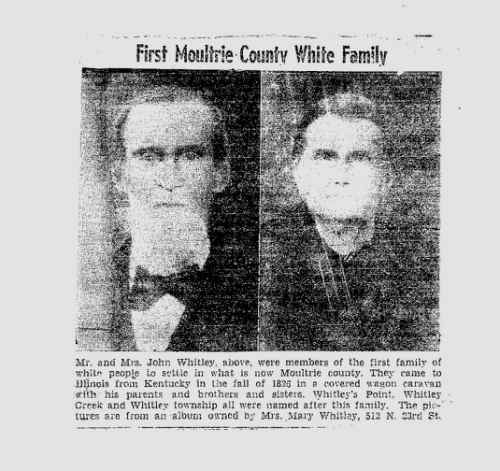
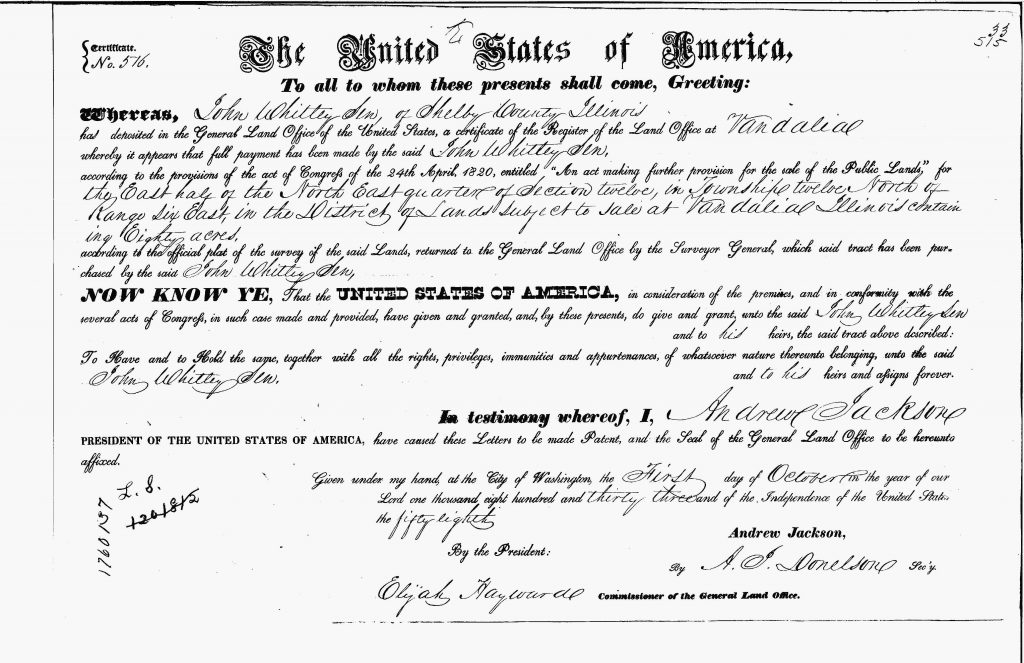
From Combined History of Shelby & Moultrie Counties, Illinois: and biographical sketches of some of their prominent men and pioneers; Philadelphia: Brink, McDonough and Co., 1881.
“John Saunders Whitley left Virginia ca 1791 and traveled westward through North Carolina, Tennessee and Kentucky. After 20 years reached Illinois, reaching the Kaskaskia River. By 1826, John Saunders with his wife and all their children and the families of their children were the first to settle in what is today know as Moultrie County, Illinois. He and his family members are mentioned numerous times in the History of Shelby and Moultrie Counties and played a large part in the settlement of Illinois, leaving behind them such landmarks as Whitley Township (Whitley’s Point) and Whitley Creek. He served in many public offices and was a soldier in the War of 1812 (Blackhawk War). Three of his children came to Texas in January 1835 and several moved to Missouri.
The honor of first settling in the territory comprising Moultrie County, belongs to John Saunders Whitley. He with his wife and sons John, Sharp, Mills, Randall, William, Josiah, his son-in-law Samuel Lindley, and two or three daughters, settled in Section 12, T. 12, R. 6, at the point of timber which has ever since been known as Whitley’s Point, in the fall of 1826. This farm is now owned by J. M. Edmonds. Here he erected the first cabin and broke the first prairie in what is now Moultrie County.
All his sons but Josiah were married, and some had children, when they came and settled in the same vicinity, as did also the son-in-law, Samuel Linley. The senior Whitley was a native of Maryland (Virginia), and it is thought came from Kentucky here. He and all his sons were very fond of sport, great horsemen, and always kept a number of fine thoroughbred Kentucky racehorses. They would frequently ride some distance to settlements and race for money; in fact, gambling in general seemed to be their chief occupation. The sons were all large, athletic men, and inclined to fight at the slightest provocation. It is said that they and some of the Waggoner’s had an interesting combat at one time.
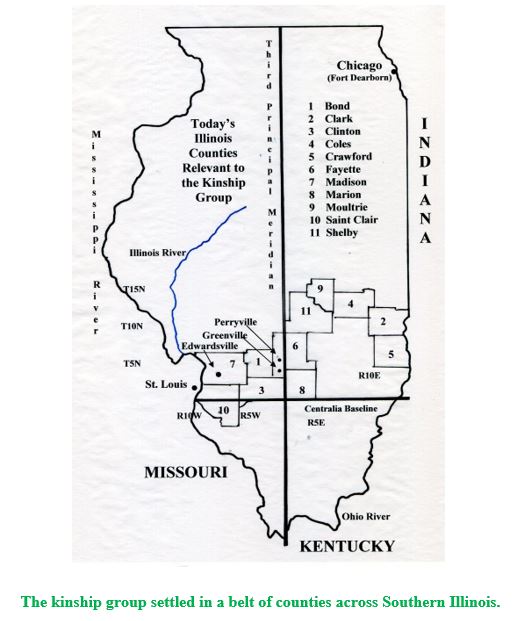
Mills and Sharp Whitley and Samuel Linley emigrated to Texas about 1836 or ’37 (1835), and John, Randall, and William died several years ago in Missouri, whence they had moved. Josiah, the last known of, was living in Bond County, this state. The elder Whitley moved up the Okaw river, in Coles County, about 1838, where he died a few years later, and his wife soon followed him in death.”
Whitleys Batemans and Littles in the Blackhawk Indian War
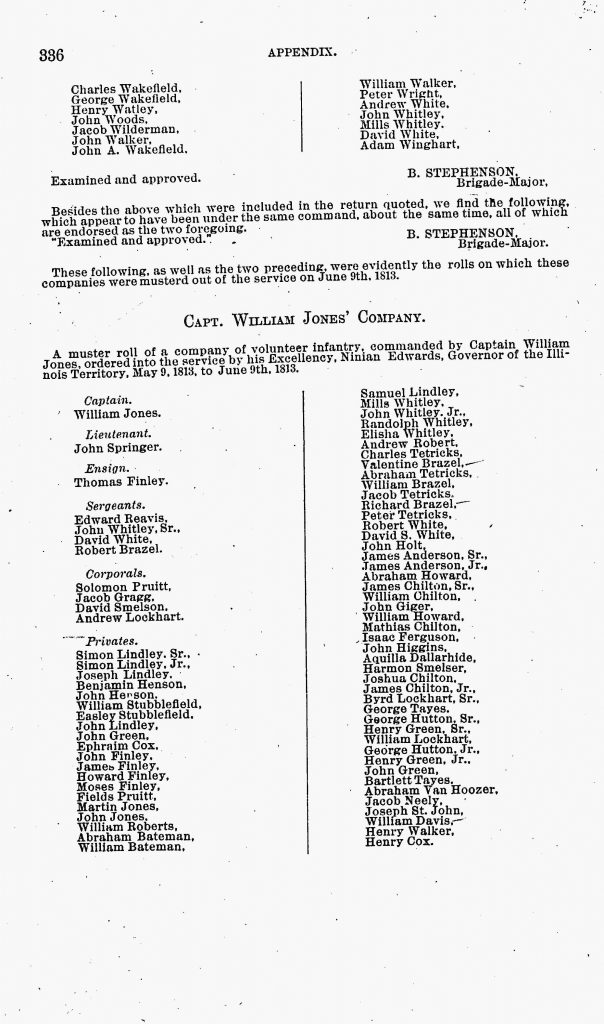
“The peaceful, steadily growing location into which new arrivals to Illinois lived and moved did not last for long. The War of 1812 not only disturbed American cities in the east. British military agents and traders in the west were quick to foment Indian depredations including the Fort Dearborn Massacre (August 15, 1818) in which the Potawatomi Indians destroyed the fortification at what later became Chicago. Many migrants, only recently arrived in Illinois, put life and limb at risk once the conflict escalated. Abraham Bateman, William Little (Heather’s 5th great grandfather), Joseph Lindley, Samuel Lindley, William Pursley, John Whitley (Heather’s 6th great grandfather), and Mills Whitley (Heather’s 5th great grandfather) are all found on Illinois muster rolls by 1813 and during the war. John Saunders Whitley served as a sergeant and Mills Whitley was a private in Captain William Jones’ company of the Illinois volunteer infantry.
Even before the formal June 18, 1812 declaration of war, Indian tribes in southwestern Illinois had become increasingly restless. As early as 1811, Indian raids elicited a defensive response from the Illinois Rangers—a local militia unit46—who turned Hill’s (a. k. a., White’s) Fort near today’s town of Greenville into a base for rendezvous. One Lindley family memoir elaborates:
Everything was very peaceful here until about 1811 when the Indians began to pillage and to kill some of the settlers. Simon Lindly [sic] was warned by an old white-haired Indian about further Indian raids. The settlers then built a stockade in which they lived but went outside to do their farming.
In the late spring of that same year, an anonymous Lindley family member experienced a harrowing episode while attempting to assist a detail of Rangers in pursuit of the Indian raiding party that had attacked a vulnerable homestead and kidnapped Rebecca Cox.
About this incident, the territorial governor Ninian Edwards wrote:
A young man, by the name of Lindley, was to have joined the party who pursued the Indians but did not arrive at the place of rendezvous in time. On his return home, he states that he was pursued and overtaken by two Indians (supposed to be those spoken of by Miss Cox in her affidavit); that after running until he was nearly exhausted, he stopped in the midst of a fallen tree, from which he shot the foremost Indian and seized his gun, and with it shot the other Indian as he came up, and actually killed both.
As the war began in earnest and Indian attacks became a sustained threat to settlers, members of the kinship group and their neighbors gravitated to the closest fortified structure or “block house.” About forty families, including the Lindleys, Littles, Whitley, and Pursleys, spent the better part of the conflict inside Hill’s Fort, a fortification in then-Madison County, Illinois. During the four-year conflict, the Indians attacked the settlers’ refuge four different times. Even give the dislocation, some semblance of normality remained. On February 17, 1814, in a ceremony conducted by Ranger Captain and Shoal Creek Church Primitive Baptist minister, William Jones performed the wedding (quite likely held within Hill’s Fort) of Mills Whitley and Elizabeth Little (Heather’s 5th great grandparents). One week later, Jones again officiated at the nuptial of Mary Little (Elizabeth’s sister) and Thomas Heaven Finley. Lydia Little Pursley, the sister of Elizabeth and Mary, soon thereafter acquired local celebrity of a very different kind.
In family history, the most fêted wartime heroics occurred during a very nearly successful September 8, 1814, Indian attack against Hill’s Fort. An historical marker atop William Pursley’s Illinois grave site even commemorates the event. On that date, Pursley and a dozen other men left the safety of the fort only to be ambushed by a large party of hostile Indians. In a fiercely fought skirmish, somewhere between two and four of the fort’s defenders died. Another man was severely wounded. The survivors retreated back into the fort, except for Tom Higgins who stood his ground for “one more pull at the enemy.” Three tribesmen pursued Higgins, shooting him first and then closing upon their victim with knives, tomahawks, and spears. Higgins shot one of the oncoming Indians, but the other two continued their advance. As hand-to-hand combat ensued, the Indian war party in the rear began moving forward to assist.
When none of the Rangers who had retreated into the fort responded to Lydia Little Pursley’s entreaties to rush to Higgins’s aid, William Pursley’s wife found a gun, mounted a horse, and rode out of the fort to help the struggling Ranger. Inspired by Lydia’s courage, and perhaps also shamed by her pointed taunts, others within the fort abandoned timidity and followed to render assistance. Thus was Higgins rescued and carried to safety within the fortification’s walls. Notwithstanding seven bullet wounds and a tomahawk blow that severed Higgins’s ear laying “bare his skull to the back of his head,” the wounded Ranger survived the brutal encounter. Simon Lindley’s daughter Elizabeth, who as a ten-year-old witnessed the entire engagement, recalled in later life that her father helped remove the bullets from Higgins’s body while her twenty-one-year- old brother Joseph rode to fetch both reinforcements and a doctor.
Not long after this incident, the inhabitants of Hill’s Fort chose wisdom over valor and abandoned the block house. Most within the kinship group withdrew west to Edwardsville.”
In the fall of 1825, Samuel Little (b. 1780-1790) abandoned Bond County for the less developed, more remote Shelby County to Bond’s immediate northeast. Traveling in an ox cart, he transported his family and all their possessions to western portion (section 18) of Ash Grove township where he built a cabin and became the first settler in that area. He was soon followed by John Little and John’s wife Betsey Bateman, as well as John’s in-laws Robert and Nancy Bateman Duncan. John settled on the side of Wabash Creek immediately southeast of Samuel and some 150 yards from the mouth of Willow Branch. In his new location, John cleared half a dozen acres of timberland and planted corn. Meanwhile, Duncan squatted in the section due east of Samuel on the west side of the Wabash Branch. An early history of Shelby County described these extended family members as “regular frontier-men” who “delighted to hunt and have sport with the neighboring Indians.”
In the meantime, John Saunders Whitley Sr.’s family forsook Bond County for Shelby. His residence in Bond dated from no later than February 1813. In the fall of 1826, thirty-five family pilgrims, including seventeen of John Sr.’s grandchildren, moved en masse into the raw frontier. They traveled somewhat farther northeast than the Littles and Duncans, settling in what became Moultrie County in 1843. The location is known still today as Whitley Township. Whitley family migrants either walked or rode in the wagons transporting the family’s belongings along a primitive wilderness trail that ran northeastward out of Greenville; up Shoal Creek; on to Cold Springs; and finally, into Shelby County where they stopped at Williamsburg Hill’s south side.
These “energetic and enterprising” Whitleys, christened “real men” in a late- nineteenth century Moultrie County history, were the first to settle the area. Included in the migration were John Sr., his wife Bathsheba Bateman, sons Sharp, Mills, Randall, William, and Josiah, and son-in-law Samuel Washington Lindley (married to Elizabeth Whitley, b. 1795 Virginia).
The Whitleys made a profound impression during their Moultrie County years. John Sr. constructed the county’s first horse-powered mill. When Moultrie was still part of the newly created Shelby County (1827), John Sr. was one of five county commissioners selected in the first county election. John’s son Sharp was a member of Shelby’s first petit jury. So were fellow-kinship-group members William Little Sr., Samuel Little, and Robert Duncan. John Whitley’s son Mills served on Shelby County’s first grand jury.
Describing the character and quality of the Whitley family, a late-nineteenth century history of Moultrie County explains, “John Sr. erected the first cabin and broke the first prairie in what is now Moultrie County He and all his sons were very fond of sport, great horsemen, and always kept a number of fine thoroughbred Kentucky race horses [as well as “hunting hounds”]. They would frequently ride some distance to settlements and race for money; in fact, gambling in general seemed to be their chief occupation. The sons were all large, athletic men, and inclined to fight at the slightest provocation.”
One Whitley family historian colorfully elaborated on these family qualities, writing:
“The Whitleys, along with all the other settlers, spent Sundays at the Indian village. Friendly horse-racing, shooting, and wrestling contests showed the Indians that the Whitleys and others could match their best, and they must have developed a healthy respect for each other through these contests. Corn whiskey was the prize for the contests, and by nightfall, everyone was probably feeling happy. A preacher from the Methodist settlement at Wabash Point in Coles County tried to put a stop to these Sunday games.”
By 1830, Shelby County was home for almost the entire cluster of kinship members that very soon would migrate to Texas. William Sr., Samuel, John (the husband of Elizabeth “Betsey” Bateman), and William Little lived in Precinct Five. John Bateman, and Robert and Nancy Bateman Duncan were found in Precinct Four. The Duncans were separated from two brothers, Mills and Sharp Whitley (both married to daughters of William Little Sr.) by only a single dwelling. Although the Duncans remained in Illinois, both Whitley brothers became part of the 1830s migration to Texas. Another Whitley brother, William, lived eight households beyond. He eventually moved to Missouri, not Texas, but his nearby neighbor, John Sadler (married to Barsheba Lindley), arrived in the incipient Texas Republic early enough to participate in revolutionary events. Beyond the Sadler household, Whitley family patriarch, John Saunders Whitley Sr. lived alongside the son and namesake. And only a single household separated John Jr. (who eventually trekked to Missouri) from Wright Little, probably the second-oldest son of William Sr.71
Another force igniting Texas Fever was enthusiastic, aggressive promotional literature of the period.84 This was probably far more significant than nostalgia for good times with old Indian friends. Unimaginably large tracts of land were available to those who dared making the trek to Texas. The lure of thousands of obtainable acres no doubt drew the majority within the kinship group
During the 1830s, the kinship group examined herein moved into what, at the time, was either the Sabine District or Vehlein Colony. The principal “pentapolis” of families coming to Texas directly from Illinois included Batemans, Lindleys, Littles, Sadlers, and Whitleys.
Excerpt:
Whitleys Batemans and Littles in the Battles for Texas Independence
Jonathan came to Texas with the party of his father, Samuel Washington Lindley. By December 1835, Jonathan, along with his cousins Joseph Lindley and John Thomas Whitley (Heather’s 6th great-uncle), and his brother-in-law Hiram Little, were among the 300 Texian volunteers who participated in the December 5-9, 1835,98 Siege of Bexar during which legendary “Old Ben Milam” fell. The engagement successfully pried San Antonio de Bexar from a Mexican army of 1,200 under the leadership of Perfecto de Cos, general and brother-in- law of Santa Anna himself. Following the siege, Whitley returned to the future Montgomery County (later divided in the Walker County) where he owned a farm. Little, quite possibly accompanied by his brother-in-law Jonathan Lindley, went back to his then-home in the Sabine District where both men held property. Joseph Lindley also departed San Antonio.
Between the Siege of Bexar and San Jacinto, Texian revolutionaries suffered a seemingly irreversible February-March 1836 defeat as Santa Anna’s army decisively overwhelmed those 189 hopeful soldiers, including their leaders, Travis, Bowie, and Crockett, in their makeshift Alamo fortress. Jonathan Lindley (Heather’s cousin by marriage), back in San Antonio no later than February 1, 1836, was one of the 189—and the only Illinoisan—who died March 6 at the Alamo.
Forty-six days later, on April 21, 1836, another of Jonathan Lindley’s brothers-in- law, John Sadler (distant cousin) —a fifth family member who participated in the Revolution—fought in Captain William Ware’s company along with Sam Houston at the Battle of San Jacinto.101 So did Joseph Lindley, 102 the first cousin both of John Sadler’s wife, Barsheba Lindley, and the fallen Jonathan Lindley. Knowing that their kinsman Jonathan had died at the Alamo some seven weeks before, it is easy to imagine both Sadler and Joseph Lindley shouting, “Remember the Alamo!,” with particular and personal vigor as they they descended on Santa Anna’s soldiers at siesta.”
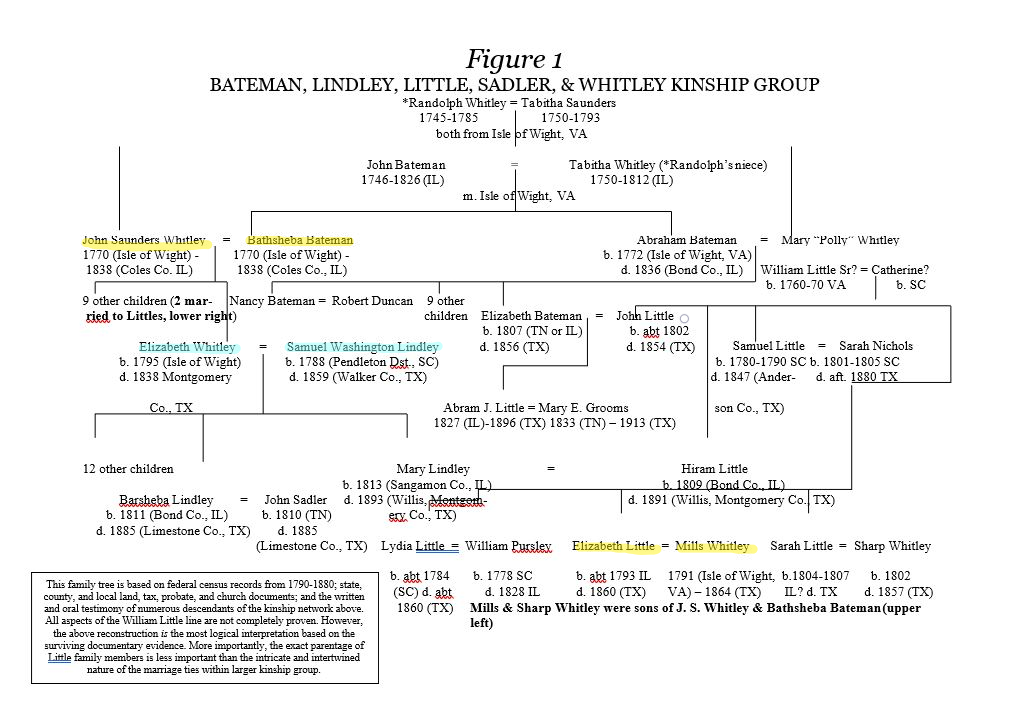
“Within two years after the Revolution, almost all members of the kinship group were ensconced in Montgomery County (created in 1837 from the then-large and sprawling Washington County). The extended family dramatically demonstrates the principle so ably articulated by Carolyn Billingsley in the title of her groundbreaking volume, Communities of Kinship. The 1838 county tax assessor listed Mills (5th great grandfather) and John Whitley, William Spiller, John Sadler, and Hiram Little all living side by side. John Spiller, William Lindley, Samuel W. Lindley, John Little, Lemuel Collard, and Sharp Whitley were in close proximity.”
Mills Whitley Biography:
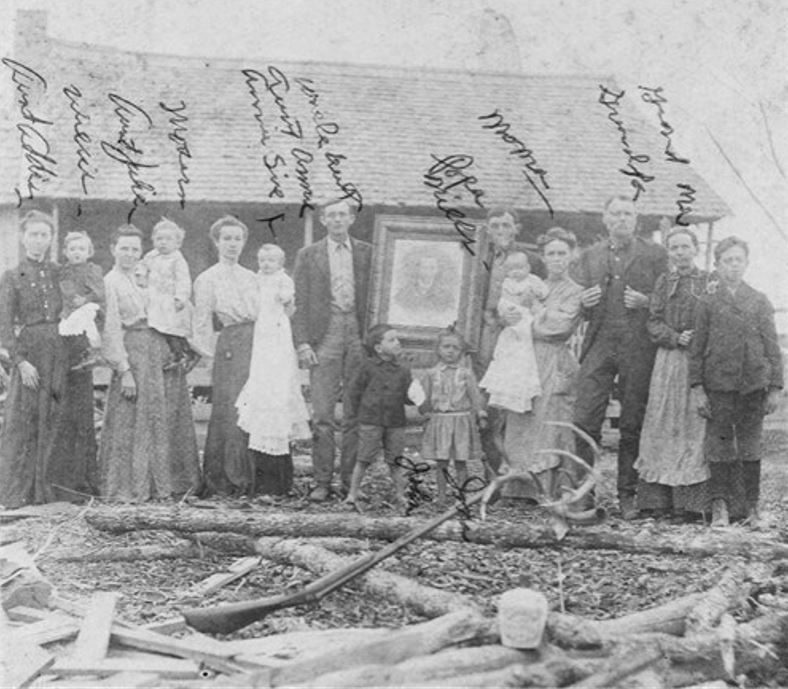
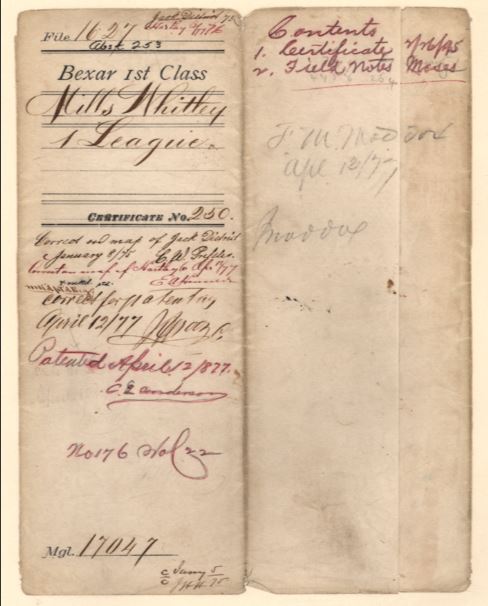
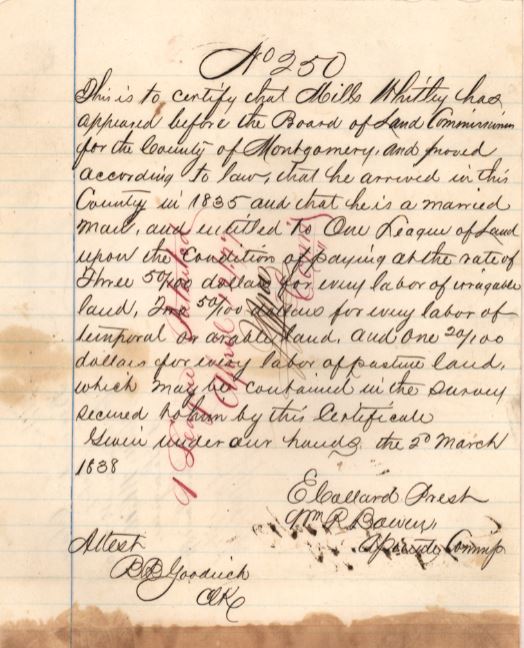
“Mills Whitley was born in Johnston County, North Carolina in 1792 or 1794. His father was John Saunders Whitley and his mother was Bathsheba Bateman. His father moved to Illinois Territory 1811 – 1813.
Mills married Elizabeth Little of South Carolina on April 2, 1814, in Madison County, Illinois. Their children were Sarah, John, William, Josiah, Sharp, Elizabeth, and Randolph all born in Illinois. Their last child Hiram was born 1837 in Texas. Mills Whitley and family moved to Texas around 1834 – 1836 (1835) near present day New Waverly, Walker County.
Mills Whitley shows up in the Sabine district census of 1829 – 1836, the first census of Texas. He and his brother Sharp show up in the 1840 census of the Republic of Texas. Mills has 5 work horses and his brother Sharp had 41 neat cattle both in Montgomery County which their part becomes Walker County.
In 1846 and October 1849 Mills sells off his land to his two sons John and William and to his brother Sharp and others.
He moved to Goliad or Caldwell County with his younger sons Randolph or Hiram in the 1850s. He died 1860 in South Texas.”
Excerpt from an other boigraphy:
“Two other Little family members came to Texas among the original pioneers: Elizabeth (1792-1860) and Sarah (b. 1807), married to respective Whitley brothers, Sharp and Mills (siblings of Elizabeth Whitley, the wife of Samuel Washington Lindley). The Whitleys probably came to Mexican Texas in the company of Hiram and William Little. The forty-five-year-old Mills Whitley (ancestor), his forty-three-year-old wife Elizabeth Little (ancestor), and their minor children ages one to eighteen reached Texas in early 1835. So did thirty- three-year-old Sharp Whitley with his “thirty-something” wife, Sarah Little. Shortly after their arrival, both couples settled in the Montgomery-Walker County area alongside the bulk of the kinship group. Mills remained in that location for eighteen years.
Like other members of the kinship group, both Mills (1791-1864) and Sharp (b. 1802 Tennessee / d. 1857 Texas) remained alert to unfolding opportunities on the Texas frontier. However, rather than migrating northwestward up the Trinity and Brazos River valleys as did Joseph Lindley, John Sadler, and the three restless Littles, the Whitley brothers largely followed a southwesterly course into counties where other members of the kinship group did not go. Admittedly, Sharp held acreage in today’s Kaufman County (1844), Henderson County (1845), and Washington County (1850), but he eventually moved to Lavaca County well south of the kinship group’s principal base. He owned 500 Lavaca County acres from the time of his 1851 arrival in Lavaca and lived there until his 1857 death.181 Meanwhile, Mills remained in Montgomery County through 1853 but relocated the following year in Caldwell County where he resided until his death in 1864.”
From book Sons of the Republic of Texas on Google Books:
http://books.google.com/books?id=qBQEiQ5hEEgC&lpg=PA175&ots=LVCsh7Z0A1&dq=s ons%20republic%20texas%20mills%20whitley&pg=PA175#v=onepage&q=sons%20republic%20texas%20mill s%20whitley&f=false
Transcribed Bible Record : Posted 02 Aug 2012 by NancyECramer
Copy of this transcribed Whitley Family Bible record can be found in the Jonathan Lindley file at the DRT Library at the Alamo, San Antonio, Texas. Transcribed copy (typescript) of pages from a Whitley Family Bible in the possession of Mrs. Maude Whitley Breckenridge, El Dorado Springs, Missouri. The Bible is in very fragile condition with the title page missing. It is said that the Bible appears to have been exposed to water and weathering at on time. A story is related that during the Civil War, the Bible was hidden in a well to prevent its destruction.
Column one: John Sanders Whitley was born February the 14th 1770. Mills Whitley was born Sept 25, 1791, John Whitley was born December 25, 1793, Elizabeth Whitley was born December 1795, John Whitley departed this life Nov 5, 1881. Column two: Randolph Whitely was born January 16, 1798 Ellisa Whitley was born 17 August 1800, Sharp Whitley was born august the 8, 1802, Abraham Whitley was born October 1804, William Whitley was born Apr 1806, Josiah Whitley was born July the 3, 1813, Clarinda Whitley was born February the 3, 1815.
A Reminder of What Frontier Life Was Like
The story you will read below is not about one of your ancestors. The part that caught my attention was its location and timing in relation to your pioneer ancestors. It is a story of an Indian attack in Center Point, Texas in 1871. Alfred and Delilah Bishop – Vann ancestors – were living in the small town of Center Point at the time and Malachi and Caroline Weston were in Kerrville, just 10 miles north. Jonathan Scott lived in Kerrville in the previous decade and had moved on to Gonzales by 1871.
These are the stories that remind us of just how primitive and dangerous conditions were for our families at that time. Kerr county was literally on the frontier 150 years ago:
HARROWING EXPERIENCE OF MRS. KIRBY
I ran across this story of a frontier incident in Center Point, Texas. The people in the story are not your relatives, but in 1871 your ancestors Alfred and Delilah Bishop were living in Center Point. The Vanns, moved to Kerrville (10 miles north of Center Point) the next year. The Scotts lived in Kerrville from 1856 – 1862 and Caroline Scott married Malachi Weston and they were living in Kerrville in 1871.
It’s always interesting to learn about what life was like for our family during the pioneer days in the 1800s. They were living on the frontier of Anglo civilization enduring great hardships. This story helps put their lives in perspective.
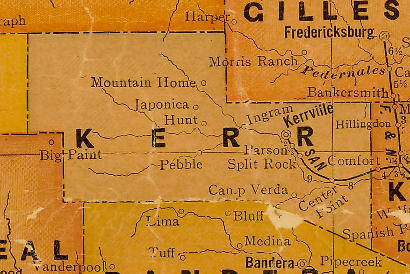
From Hunter’s Frontier Times Magazine, July, 1927
“Indians in 1871 killed the husband and two children of Mrs. E. K. Kirby, 76-year-old-resident, living with her daughter 20 miles north of Uvalde (at the time of the article, not the incident). Although Mrs. Kirby remembers vividly the details of the Indian raid, it is only upon rare occasions that she can be induced to talk about the killing of her three loved ones, the wounding of her 18-month-old-babe, Joel; the kidnapping of her little girl, and the fearful pain in her shoulder as she jumped from a 20 foot bluff to escape the Indians who had shot her in the shoulder and were intent upon scalping her. Mrs. Kirby was then Mrs. Terry.
The horror of the toll of life taken by the Indians has remained with the pioneer woman. She married again several years after the raid, and she has tried to make the best of life. Every calamity seems small when compared to the disaster which cost her so much, she declares.
“Just because the crops fail, or the cattle die, is no reason for anyone to be discontented. People of today should be happy and content because they can live in peace and security, and because they are not forever cursed with the dread of an Indian raid,” said Mrs. Kirby.
“We were living in a tent located on a small hill about a half mile from Center Point and had been there about a month before the Indian raid,” said Mrs. Kirby. “My husband, Mr. Terry, was cutting timber to build us a home. One afternoon in January, while he was shaving shingles about 200 yards from our tent, he called me to bring him some tobacco. I started with it, but when I was halfway to him, Indians rushed out of the brush and shot him.
“I turned and ran toward my children, who were in the tent. However, the Indians reached the children before I did. They pierced Carrol, my three year old boy, with a lance, and crushed the life from my 6-week-old baby with a rock. I became crazed with fright and jumped from the bluff back of the tent, thinking that I would die with my family and cheat the Indians. One of the Indians’ bullets struck me in the shoulder. Later I counted nine bullet holes in my dress.
“The jump from the bluff, by some miracle, failed to seriously injure the fear-crazed woman. She made her way to the home of a neighbor and gave the alarm. A party of men set out immediately for the scene of the murders. The Indians were gone, and had taken with them the little girl, Martha. Joel, 18- month-old child, was found alive in the tent. He was rushed to his mother and her care had much to do with the saving of his life. Joel is now living on a ranch 10 miles south of Leakey, in Real County.
A company of heavily armed men set out, hoping to recover the stolen girl and exact vengeance for their bloody crimes. The pursuers learned that the Indians had also captured Jack Hardy, a negro boy of the Center Point community. Riley Van Pelt, who lives in the neighborhood of Rio Frio, while then only a small boy, remembers the incident and relates the story of the pursuit. The little girl was brought to the house, where she remained until the men could rest sufficiently to take her home.
“Hardy, the negro boy, who was also captured by these Indians, used to live at Center Point, and he has told me about the raid. He said that he saw Mrs. Kirby jump from the bluff and he thought that she could not possibly live. When the Indians neared the Rio Frio settlement with two Indian guards to herd the stolen horses on a hill, while the others went down into the valley after more hores, Hardy succeeded in slipping away from his guards while they were interested in watching their companions below.
“While crawling through the brush, Hardy said that he heard the crackling of a twig, and prepared to see one of his captors, but he looked up into the satisfied countenance of an old milk cow.” continued Van Pelt. “he succeeded in reaching some men below in the field, who organized a searching party and overtook the redskins.”
Bill Pruitt, who lived near the Leakey Settlement, and John Patterson, were in the party of white settlers who overtook the Indians, and both glimpsed the girl at the same time. Both started after the Indian behind whom the captive was riding and pressed him so closely that he knocked the little girl off as he abandoned his horse and plunged into the brush. After seeing the girl, the men followed the redskins some distance, but found only a trail of blood, and a bloody blanket, filled with bullet holes. The girl was kept at the Van Pelt place for several days, and, since the general belief among the settlers was that the mother had been killed, she was taken by one of the men, whose intention it was to adopt her.
“The raid occurred in January,” said Mrs. Kirby, and l did not get my daughter back until sometime in April. People living near Rio Frio thought the negro boy knew what he was talking about when he told them I was dead, so they would not give my little girl to me at first. She was with the Indians eight days, and people who helped to capture her kept her for the rest of the time until she was returned to me.”